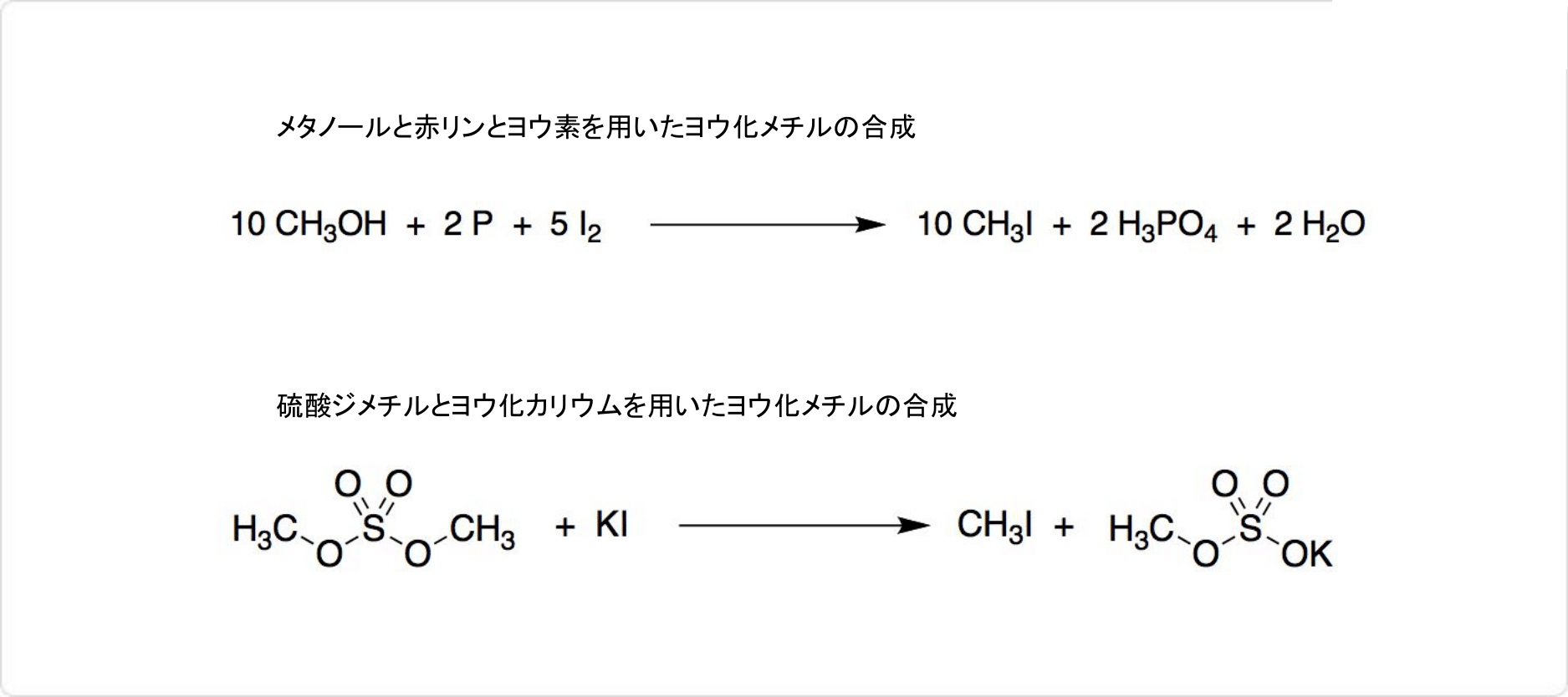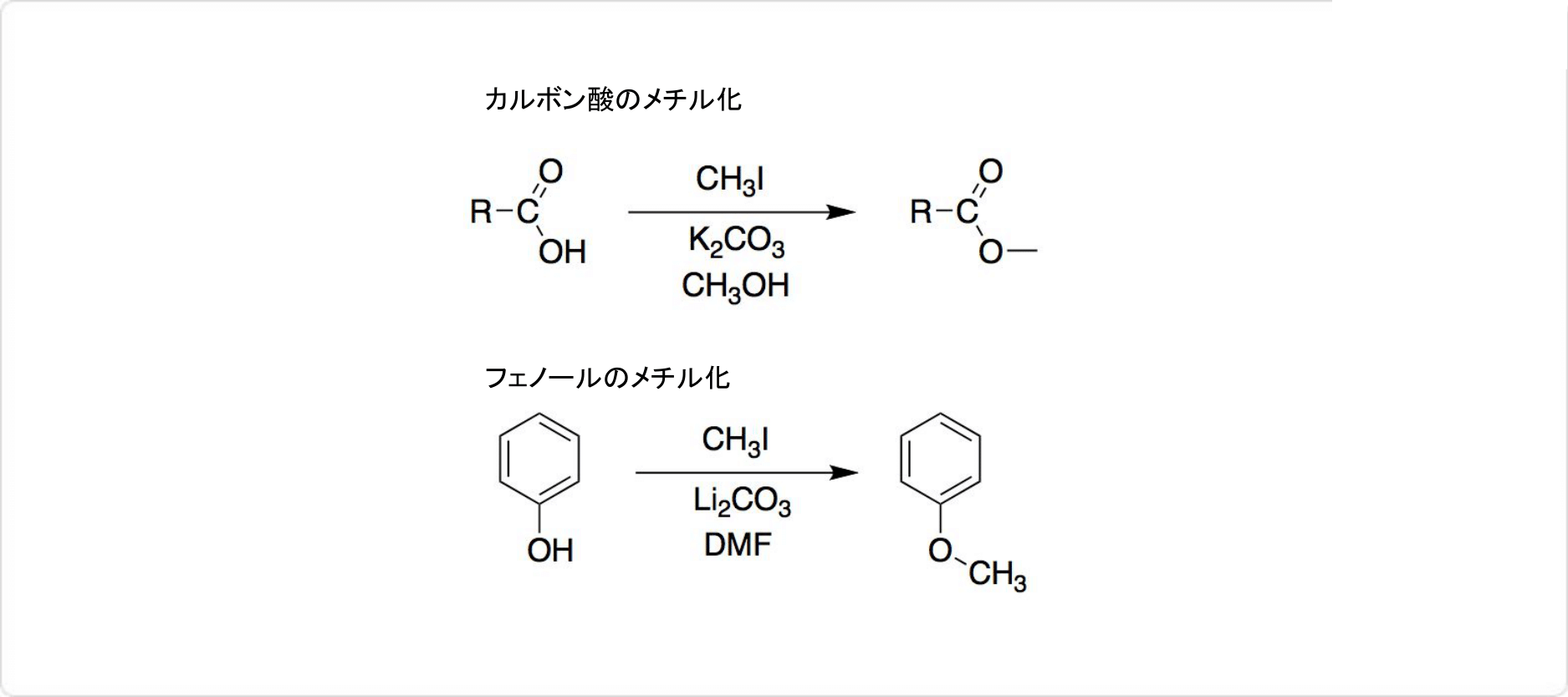-
外観
無色~褐色, 澄明の液体
-
性質
ヨウ化メチルは無色〜褐色の液体で、特徴臭がある毒性が高い化合物です。融点は-66.45°C、沸点は42.43°Cです。
エーテルやアルコール等の各種有機溶剤によく溶解します。及びに対しても極めて溶けやすいです。水への溶解性は、冷水に対して1.4g/100mlであり、難溶です。
一部のヨウ化メチルは、空気中で光によって分解します。分解によって薄い紫色を帯びるため、褐色ビンにより暗所保存する必要があります。その際に安定化剤として、銅を使用可能です。
なお、ヨウ化メチルの化学式はCH3I、モル質量は141.94g/mol、20°Cでの密度は2.2789g/cm3です。ヨウ化メチルの分子は、四面体形構造を取っています。
-
溶解性
水に難溶 (1.4g/100ml 冷水), アルコール, エーテル等各種有機溶剤に可溶。エタノール及びアセトンに極めて溶けやすく、水にやや溶けやすい。
-
解説
ヨウ化メチル.ヨードメタンともいう.硫酸ジメチルにヨウ化カリウム水溶液を反応させるか,メタノールにヨウ素と赤リンを作用させると得られる.液体.融点-66.5 ℃,沸点42.4 ℃.d2042.279.n20D1.5317.有機溶媒に可溶,水に微溶.多くの第三級アミンと反応して第四級アンモニウム塩を生成するなど,有機合成におけるメチル化剤として用いられる.空気中で光により一部分解して褐色になるので,冷暗所に保有する.光を当てるとヨウ素を遊離して着色する。ヨウ化カリウムの水溶液に硫酸ジメチルを加えれば得られる。メチル化剤として用いられるほか、医薬の発泡剤に用いられることもあるが、皮膚に付着すると炎症をおこし、蒸気を吸入すると神経障害をおこし、かつ習慣性がある。ラットの経口半数致死量(LD50)は体重1キログラム当り20ミリグラム。
-
用途
有機合成原料、メチル化剤、医薬?農薬(殺虫剤)原料
-
合成

図3. ヨウ化メチルの合成
メタノールとの混合物に、ヨウ素を反応させることで、ヨウ化剤の三ヨウ化リンが生じ、発熱しながらヨウ化メチルが生成します。反応混合物を蒸留して、チオ硫酸ナトリウム水溶液によってヨウ素を除去し、炭酸ナトリウム水溶液によってリン酸を除去します。乾燥したのち再度蒸留すると、ヨウ化メチルを得ることが可能です。
シリカゲルやアルミナを用いたカラムクロマトグラフィーを使用して、ヨウ化メチルを精製できます。それ以外にも、ヨウ化カリウム水溶液中にとを加えると、高い収率でヨウ化メチルが生成します。
-
化学的特性
light yellow to light pink liquid
-
物理的性質
Clear, colorless liquid which may become yellow, red, or brown on exposure to light and moisture
-
使用
.Iodomethane is an approved pesticide used to control insects, plant parasitic nematodes, soil borne pathogens and weed seeds.
-
定義
ChEBI: A member of the class of iodomethanes that is methane in which one of the hydrogens is replaced by iodine.
-
調製方法
Methyl iodide has had very limited use as a chemical
intermediate (methylations), and in microscopy because of
its high refractive index, as imbedding materials for examining
diatoms, and in tests for pyridine. It has been proposed
as a fire extinguisher and insecticidal fumigant. It is a product
of natural biological processes. Methyl iodide is a currently
registered pesticide.
-
一般的な説明
A colorless liquid that turns brown on exposure to light. Denser than water. Contact may irritate skin, eyes and mucous membranes. Very toxic by ingestion, inhalation and skin absorption.
-
空気と水の反応
Soluble in water. Sinks and slowly decomposes in water forming poisonous vapor cloud of HI.
-
反応プロフィール
Halogenated aliphatic compounds, such as Iodomethane, are moderately or very reactive. Reactivity generally decreases with increased degree of substitution of halogen for hydrogen atoms. Low molecular weight haloalkanes are highly flammable and can react with some metals to form dangerous products. Materials in this group are incompatible with strong oxidizing and reducing agents. Also, they are incompatible with many amines, alkylphosphines, nitrides, azo/diazo compounds, alkali metals (sodium), and epoxides.
-
危険性
Toxic by ingestion, inhalation, and skinabsorption; narcotic, irritant to skin. Eye damageand central nervous system impairment. Question-able carcinogen.
-
健康ハザード
Inhalation of vapor causes lung congestion and pulmonary edema. Higher concentrations causes rapid narcosis and death. Contact with liquid irritates eyes and burns skin.
-
火災危険
Noncombustible. High vapor pressure may cause containers to burst at elevated
temperatures.
-
燃焼性と爆発性
Noncombustible. High vapor pressure may cause containers to burst at elevated
temperatures.
-
作用机制
線虫などにとって必須の酵素に含まれるチオール基やヒドロキシ基などの求核中心と反応することによりその酵素を阻害し,活性を発揮する。
-
使用用途
ヨウ化メチルは、の代替として、殺センチュウを目的とした脂肪族ハロゲン化物の燻蒸剤として主に用いられます。細菌や糸状菌による病害に対する防除効果もあります。
適用作物には、果樹、野菜及び花き等があり、路地及び施設でのメロンやトマトのネコブセンチュウ、倉庫及び天幕でのクリのクリシギゾウムシやクリミガ等に適用可能です。
殺虫効果が得られる理由は、蒸気として土壌、作物又は木材内部に拡散し、塩基性要求核中心と反応すると、ピルビン酸脱水素酵素やコハク酸脱水素酵素などの必須酵素を阻害するためだと考えられています。
-
関連する反応
1. ヨウ化メチルの反応

図2. ヨウ化メチルを用いた反応
ヨウ化メチルは、グリニャール試薬 (英: Grignard reagent) のMeMgIの前駆体です。モンサント法で、ロジウム錯体と反応すると、ヨウ化アセチルを生じます。
ヨウ化メチルはメチル化剤として、SN2反応で良く使用されます。具体的には、カルボン酸やのメチル化などです。メチル化反応では、や炭酸カリウムのような塩基がプロトンを捕捉して、アニオンが生じ、SN2反応のための求核剤を供給します。
2. メチル化剤としてのヨウ化メチル
有機合成化学では、ヨウ化メチルはメチル化剤としてよく利用されます。ただし、等物質量のと比べると、ヨウ化メチルは2倍の重量が必要です。しかし、塩化メチルは気体であり、液体のヨウ化メチルは扱いやすいです。
それに加えて、メチル化の能力も、塩化メチルより優れています。一般的なヨウ化物は塩化物や臭化物よりも高価ですが、ヨウ化メチルは安価です。その一方で、ヨウ素原子は脱離して求核剤になるため、副反応の原因になりやすいです。
-
安全性プロファイル
Confirmed carcinogen
with experimental neoplastigenic and
tumorigenic data. A poison by ingestion,
intraperitoneal, and subcutaneous routes.
Moderately toxic by inhalation and skin
contact. A human skin irritant. Human
mutation data reported. A strong narcotic
and anesthetic. Explosive reaction with trialkylphosphines, silver chlorite. Violent
reaction with oxygen (at 3000C), sodium.
When heated to decomposition it emits
toxic fumes of I-.
-
職業ばく露
Methyl iodide is used in fire
extinguishers; as an intermediate in the manufacture of
pharmaceuticals and some pesticides.
-
発がん性
Druckrey et al. reported
local sarcomas following weekly subcutaneous injection in
BD strain rats. Strain A mice (a susceptible strain) that were
injected with methyl iodide were reported to have a slight but
significant increase in the number of lung tumors per mouse.
Poirer et al. administered iodomethane dissolved in
tricaprylin to male and female strain A mice (10/sex/dose)
three times weekly by intraperitoneal injection. There was a
marginally statistically significant trend for increased lung
tumors in treated mice but the outcome was considered
equivocal: no clear dose–response relationship and occurrence
of spontaneous tumors in untreated mice.
Under the 2005 Guidelines for Carcinogen Risk Assessment
(121), the lack of available evidence suggests that there
is “inadequate information to assess the carcinogenic potential
for iodomethane.”
An early evaluation by the IARC classified
iodomethane as carcinogenic in rats. Two subsequent evaluations
(123, 124) determined that there is limited evidence
for carcinogenicity in experimental animals and the compound
is not classifiable regarding carcinogenicity to
humans. ACGIH has also reviewed iodomethane
carcinogenicity and classified it as category A2, suspected
human carcinogen; however, the A2 classification was withdrawn
in 1996. Iodomethane was delisted as a carcinogen
in the NTP 5th Annual Report on Carcinogens on the
basis of the 1986 IARC reevaluation. NTP
has not tested iodomethane for carcinogenicity. The State of
California determined under Proposition 65 that methyl
iodide is a carcinogen, based on the 1977 IARC evaluation. Neither a Toxicological Profile nor an
Environmental Health Criteria Monograph has been
published.
-
環境運命予測
Chemical/Physical. Anticipated products from the reaction of methyl iodide with ozone or OH
radicals in the atmosphere are formaldehyde, iodoformaldehyde, carbon monoxide, and iodine
radicals (Cupitt, 1980). With OH radicals, CH2, methyl radical, HOI and water are possible
reaction products (Brown et al., 1990). The estimated half-life of methyl iodide in the atmosphere,
based on a measured rate constant for the vapor phase reaction with OH radicals, ranges from 535
h to 32 wk (Garraway and Donovan, 1979).
Hydrolyzes in water forming methyl alcohol and hydriodic acid. The estimated half-life in water
at 25 °C and pH 7 is 110 d (Mabey and Mill, 1978). At 70 °C, the hydrolysis rate was determined
to be 3.2 x 10-5/sec which is equivalent to a half-life of 6 h. (Glows and Wren, 2003). May react
with chlorides in seawater to form methyl chloride (Zafiriou, 1975).
-
合成方法
ヨウ素とリンにメタノールを反応させ,蒸留精製して製品とする
-
輸送方法
UN2644 Methyl iodide, Hazard Class: 6.1;
Labels: 6.1-Poison Inhalation Hazard, Inhalation Hazard
Zone B
-
純化方法
Methyl iodide deteriorates rapidly with liberation of iodine if exposed to light. It is usually purified by shaking with dilute aqueous Na2S2O3 or NaHSO3 until colourless, then washing with water, dilute aqueous Na2CO3, and more water, drying with CaCl2 and distilling. It is stored in a brown bottle away from sunlight in contact with a small amount of mercury, powdered silver or copper. (Prolonged exposure of mercury to methyl iodide forms methylmercuric iodide.) Methyl iodide can be dried further using CaSO4 or P2O5. An alternative purification is by percolation through a column of silica gel or activated alumina, then distillation. The solution can be degassed by using a repeated freeze-pump-thaw cycle. [Beilstein 1 IV 87.]
-
不和合性
May form explosive mixture with air.
Slowly reacts with water forming poisonous hydrogen
iodide. Incompatible with oxidizers (chlorates, nitrates, peroxides, permanganates, perchlorates, chlorine, bromine, fluorine, etc.); contact may cause fires or explosions. Keep
away from alkaline materials, strong bases, strong acids,
oxoacids, epoxides. Violent reaction with strong oxidizers,
strong reducing agents, strong bases; trialkylphosphines,
silver chlorite; calcium, oxygen, sodium. Decomposes @
270�C. Halogenated aliphatic compounds are moderately or
very reactive. Halogenated organics generally become less
reactive as more of their hydrogen atoms are replaced with
halogen atoms. Low molecular weight haloalkanes are
highly flammable and can react with some metals to form
dangerous products. Materials in this group are incompatible with strong oxidizing and reducing agents. Also, they
are incompatible with many amines, alkylphosphines,
nitrides, azo/diazo compounds, alkali metals (sodium), and
epoxides
-
廃棄物の処理
Consult with environmental
regulatory agencies for guidance on acceptable disposal
practices. Generators of waste containing this contaminant (≥100 kg/mo) must conform to EPA regulations governing storage, transportation, treatment, and
waste disposal






